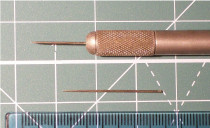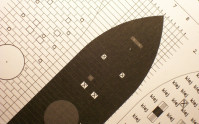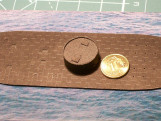- Details
-
Category: Uncategorised en
-
Published: Thursday, 26 January 2017 15:41
-
Written by Super User
-
Hits: 4831
According to naval historian R.D. Hill:
- "The (ironclad) had three chief characteristics: a metal-skinned hull, steam propulsion and a main armament of guns capable of firing "explosive shells. It is only when all three characteristics are present that a fighting ship can properly be called an ironclad."
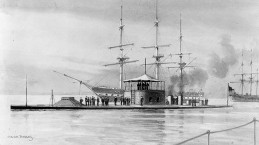
USS Monitor has not been the first ironclad in the world. In 1854 during Crimea War The French used armoured floating batteries Lave, Tonnante and Devastation. This warships has been built only for the attack of Russian coastal fortifications. Three years later the French built the first wooden-hulled armoured frigate “La Gloire”. The Royal Navy gave very fast and strong response. In 1860 was built HMS Warior the first iron-hulled and iron-plated warship in the world.

The US Navy at the time the Civil War broke out has no ironclads. In August 1861 the Union authorities heard that Confederates are going to convert the captured hull of steam frigate “USS Merimack” into an ironclad. In response Union decide to built his own ironclads. Two seagoing vessels; armoured gunboat “USS Galena”, broadside frigate “USS New Ironsides” and one offshore floating battery “USS Monitor”.
Construction.



Designed by the Swedish engineer John Ericsson, "Monitor" was described as a "cheesebox on a raft," because the key point o Ericsson's idea was revolving turret and flat hull with very low ships sides. "Monitor" had an unusually low freeboard, with the pilothouse and turret being the only permanent protrusions from the deck. Though this low freeboard greatly reduced the "Monitor's" vulnerability to gunfire compared to other naval vessels of the day, it also greatly reduced the ship's seakeeping capabilities.
The sides was low because low side is much easier to protect than high side. The hull was constructed in two parts, the upper portion sitting on top of the conventionally lower hull like the raft. It was protected by two ½ inch plates laid over the deck beams and 5 inches of side armour in 1 inch strips, backed by 25 inches of oak. The purpose of the raft was to protect the hull and the propeller against artery shots and ramming by other ship.
Air intakes and smoke holes were protected by iron grating.
The gun turret on the deck, housing two 11 in (280 mm) Dahlgen guns, paired side by side. The original design used a system of heavy metal shutters to protect the gun ports while reloading. However, the operation of the shutters proved so cumbersome, the gun crews simply rotated the turret away from potential hostile fire to reload. Further, the momentum of the rotating turret proved to be so great that a system for stopping the turret to fire the guns was implemented on later models of ships in the Monitor class. The crew of "Monitor" solved the turret momentum problem by firing the guns on the fly while the turret rotated past the target. While this procedure resulted in a substantial loss of accuracy, the loss of accuracy was not critical, given the close range at which Monitor operated. The turret comprised eight layers of 1 in (25 mm) plate, bolted together, with a ninth plate inside to act as a sound shield. Pilot house on the bow of the ship contains ships wheel and captain post.The screw has been powered by two steam engines designed by Ericsson himself, other smaller engines powered turret and ventilation system.
He monitor was launched on 30 January 1862 and commissioned to service one month later.
On March 8, 1862, "CSS Virginia" attacked the Union blockading squadron in Hampton Roads, Virginia, destroying “Cumberland” and “Congress”. Early in the battle, “USS Minnesota” ran aground while attempting to engage the "Virginia", and she remained stranded throughout the battle. "Virginia", however, was unable to attack Minnesota before daylight faded.

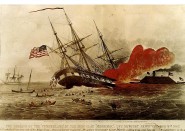
That night, "Monitor" — under command of Lieutenant John L. Worden — arrived from Brooklyn after a harrowing trip under tow. When "Virginia" returned the next day to finish off Minnesota and the rest of the blockaders, Monitor moved out to stop her. The ironclads fought at close range for about four hours, neither one sinking or seriously damaging the other. At one point, "Virginia" attempted to ram, but she only struck "Monitor" with a glancing blow that did no damage. It did, however, aggravate the damage done to Virginia's bow from when she had previously rammed Cumberland. "Monitor" was also unable to do significant damage to Virginia, possibly due to the fact that her guns were firing with reduced charges as ordered by Cmdr John Dahlgren, the gun's designer.
Towards the end of the engagement, "Virginia" by accident hit "Monitor's" pilothouse. Lt. Worden, blinded by shell fragments and gunpowder residue from the explosion, ordered Monitor to sheer off into shallow water. The command passed to the executive officer, Samuel Greene, who assessed the damage and ordered “Monitor” to turn around back into the battle.

Virginia, seeing “Monitor” turn away, turned her attention back to Minnesota. The falling tide, however, prevented her from getting close to the stranded warship. After an informal war council with his officers, “Virginia's” captain decided to return to Norfolk to repairs. “Monitor” arrived back on the scene as "Virginia" was leaving. Greene, under orders to protect Minnesota, did not pursue.
Tactically, the battle between these two ships was a draw, though it could be argued that “Virginia” did slightly more damage to “Monitor” than “Monitor” did to “Virginia". “Monitor” did successfully defend “Minnesota” and the rest of the U.S. fleet while “Virginia” was unable to complete the destruction she started the previous day. Strategically, nothing had immediately changed: the Federals still controlled Hampton Roads and the Confederates still held several rivers and Norfolk.
After battle
"USS Monitor" took part in a few small actions but according to Lincoln's orders never again participate in action against “CSS Virginia”. May 15, 1862 she engaged Confederate batteries as Drewry's her lack of of deck protection left her vulnerable to enemy fire. During the summer 1862 she was modified. Has been added a slopped glacis to protect the pilot house, fitted the ship with a telescopic smokestack, improved ventilation, davits for handling her boats and a variety of other changes to enhance her fighting power and habitability.
On May 10, 1862 advancing Union troops occupied Norfolk, "Virginia" was unable for ocean going travel through Atlantic. She was also unable to cruise up James river due to her 22 foots. In this situation her flag officer Jasiah Tattnal decide to destroy "CSS Virginia" in order to prevent capture. Guns off the "CSS Virginia" has been removed. May 11, 1862 fate of "CSS Virginia" ended in great explosion.

Because there were no duties for her at Hampton Road after she was towed to join the blockade forces off the Carolinas. Unfortunately USS “Monitor” met a big storm and sunk. 16 men from her crew has been lost. While the design of “Monitor” was well-suited for river combat, her low freeboard and heavy turret made her highly unseaworthy in rough waters. The wreck now forms a protected Federal Marine Sanctuary.

Based on:
Krzysztof Michałek, Pod banderami Unii i Konfederacji, Warszawa 1996, .
Tadeusz Klimczyk, Historia Pancernika s.16Angus Konstam, Union Monitor 1861-65. Osprey Publishing, s.
Marek Jarosz, USS Monitor, Okręty Wojenne nr 2 / 1993, s. 10.
Joel K. Bourne Jr. Żaglowce poszły w drzazgi. Pierwsza bitwa pancerników. National Geographic Polska Nr 3 (78) Marzec 2006, s. 98.
Krzysztof Michałek, Pod banderami Unii i Konfederacji, Warszawa 1996, s. 209
Wikipedia










